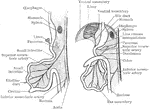
Development of the Intestinal Canal
Two diagrams to illustrate the development of the intestinal canal. The figure to the right shows the…

Development of the Great Omentum
Diagram to illustrate the development of the great omentum. A, shows the beginning of the great omentum…
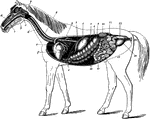
Digestive Apparatus of the Horse
The digestive apparatus of the horse. Labels: a, mouth; 2, pharynx; 3, esophagus; 4, diaphragm; 5, spleen;…
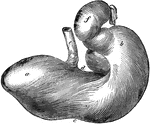
Horse Stomach
Posterior view of the stomach of a horse. Labels: a, left cul-de-sac; b, right cul-de-sac; c, greater…
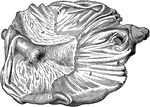
Horse Stomach
Internal aspect of a horse stomach, opened from below. Labels: a, cuticular mucous membrane; b, villous…

Digestive Organs of a Horse
The relation of anterior abdominal digestive organs- left antero-lateral view. Labels: 1, liver; 2,…
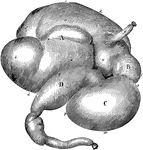
Stomach of an Ox
Stomach of an ox inflated-viewed from the right side. Labels: A, rumen; a, left sac; a', its anterior…

Stomach of a Sheep
Stomach of an sheep seen from the left side- the last three compartments are laid open and reflected…

Stomach of a Sheep
Compartments of a ruminant stomach, laid open. A, rumen- a, pillars; b, papilla; c, esophageal orifice.…
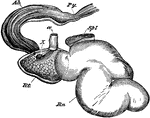
Stomach of a Deer
Stomach of a musk deer, left aspect- the last three compartments opened and reflected forwards. Rn,…
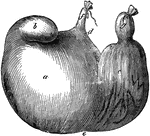
Stomach of a Hog
Stomach of a hog- inflated. Labels: a, cardiac portion; b, its accessory cul-de-sac; c, pyloric portion;…
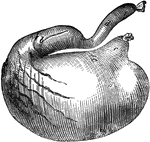
Stomach of a Dog
Stomach of a dog-inflated. Labels: a, cardiac portion; b, pyloric portion; c, esophageal orifice; d,…

Digestive Organs of a Dog
Stomach, liver, pancreas, and duodenum of a dog. Labels: a, liver; b, gall bladder; c, biliary canals;…
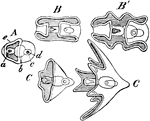
Echinopaedia
Echinopaedia is the name for the early or larval stages of echinoderms like sea stars and sea urchins.…

Crayfish
Crayfish, crawfish, or crawdads are freshwater crustaceans resembling small lobsters, to which they…

Girl Laying on Stomach & Reading a Book
An illustration of a girl laying on her stomach and reading a book.
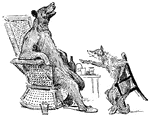
Reynard the Fox: Tricking Bruin
Reynard the Fox bets Bruin the Bear that he cannot eat a lot of honey without getting an upset stomach.…

Reynard the Fox: Bruin is Stuck
Reynard the Fox bets Bruin the Bear that he cannot eat a lot of honey without getting an upset stomach.…

Black Sea Devil with Fish in Stomach
An illustration of a black seadevil with a fish in its stomach. Black seadevils are small, deep-sea…
The Respiratory and Vocal Organs of a Rook
"Resipratory and vocal organs of the Rook, Corvus frugilegusm an Oscine Passerine bird; 1 a, tongue;…
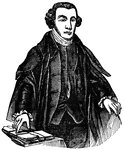
Patrick Henry
Patrick Henry, born in 1736, was an active figure in the American Revolution, known and remembered for…
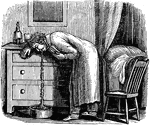
Too Much of a Good Thing, is Worse than Nothing
"He's had his fill, when he the banquet leaves; / He's eat too much - his stomach heaves: / His rich…

Human Esophagus
An Image of an esophagus showing how a mass of food, or bolus, passes through the esophagus into the…
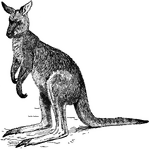
Great Kangaroo
The Great Kangaroo, or 'boomer', or 'old man' (Macropus giganteus), attains a height of about five feet…

Langur
A langur is a monkey of the genus Semnopithicus, which contains Asiatic forms characterized by slender…